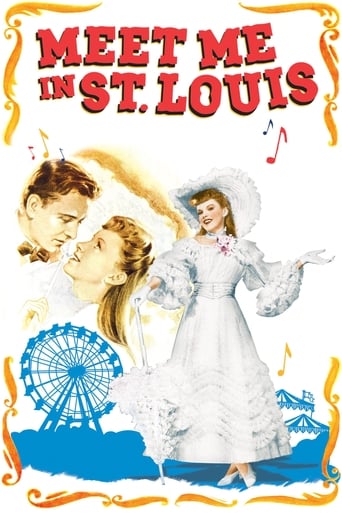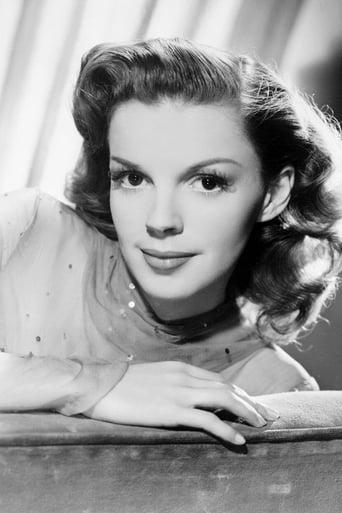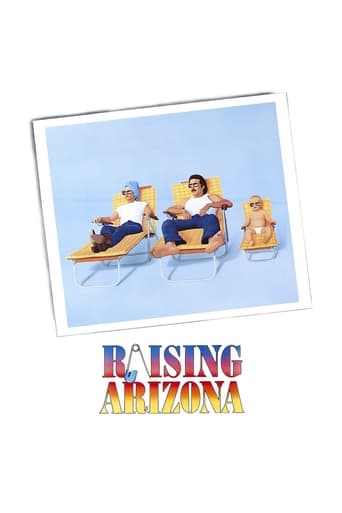Meet Me in St. Louis (1944)
The life of a St. Louis family in the year before the 1904 St. Louis World's Fair.
Watch Trailer
Cast


Similar titles
Reviews
If you don't like this, we can't be friends.
I don't have all the words right now but this film is a work of art.
best movie i've ever seen.
Bad Acting and worse Bad Screenplay
BEWARE OF FALSE REVIEWS & REVIEWERS. SOME REVIEWERS HAVE ONLY ONE REVIEW TO THEIR NAME. NOW WHEN ITS A POSITIVE REVIEW THAT TELLS ME THEY WERE INVOLVED WITH THE MOVIE. IF ITS A NEGATIVE REVIEW THEN THEY MIGHT HAVE A GRUDGE AGAINST THE FILM . NOW I HAVE REVIEWED OVER 300 HOLIDAY FILMS & SPECIALS. I HAVE NO AGENDAThe backdrop for Meet Me in St. Louis is St. Louis, Missouri in the year leading up to the 1904 World's Fair.It is summer 1903. The Smith family leads a comfortable upper-middle class life. Alonzo Smith (Leon Ames) and his wife Anna (Mary Astor) have four daughters: Rose (Lucille Bremer), Esther (Judy Garland), Agnes (Joan Carroll), and Tootie (Margaret O'Brien); and a son, Lon Jr. (Henry H. Daniels, Jr.). Esther, the second eldest daughter, is in love with the boy next door, John Truett (Tom Drake), although he does not notice her at first. Rose is expecting a phone call in which she hopes to be proposed to by Warren Sheffield (Robert Sully).Esther finally gets to meet John properly when he is a guest at the Smiths' house party, although her chances of romancing him don't go to plan when, after all the guests are gone and he is helping her turn off the gas lamps throughout the house, he tells her she uses the same perfume as his grandmother and that she has "a mighty strong grip for a girl".Esther hopes to meet John again the following Friday on a trolley ride from the city to the construction site of the World Fair. Esther is sad when the trolley sets off without any sign of him, but cheers up when she sees him running to catch the trolley mid journey.Even though the there is barely a story-line the film works. IT gets a tad slow here and there but Margret O'Brien steels every scene she is in. Judy Garland however is always a delight to watch. If you like her in this then make sure to see "In the Good Old Summertime". This film was beautifully filmed. If you can watch it on a Blu-ray.
I really don't understand a few people giving this film and Judy Garland such ugly reviews. Some people just hate anything old fashioned, I guess. This film is beautiful, and Judy Garland is gorgeous. Are a few people blind? And Judy's singing is absolutely wonderful. I must say though, that most reviews I've read, I've almost never seen anyone badmouth Judy, just on a couple reviews for this film. Other bad reviews I've read, people are usually picking at other things about Judy's films but are still saying they love Judy and her singing and they still think she's pretty. Anyway, enough about other reviewers. I think Judy is beyond pretty, she's beautiful and heavenly. And her singing is also beautiful and heavenly. I love old fashioned classics such as this film and Judy's other films. The wonderful songs in this film are "the trolley song", " the boy next door", "have yourself a merry little Christmas", and the title song. Judy and the other characters here are great including a very young Margerate O'Brien. This film and Judy are pure, sweet, wonderful, old fashioned, classic good cheer from Hollywood's golden age.
This review won't be long because I do not have too much to say about this movie. So here it is. "Meet Me in St. Louis" is about the Smith family that are living in St. Louis at the time of the Louisiana Purchase Exposition World's Fair in 1904. I don't find anything groundbreaking about this movie, because of the amount of praise it gets. Don't get me wrong, I like the movie but I don't think its a masterpiece or anything like that. For what it is, I think its fine and it is indeed watchable. The cast in this movie are good, especially for Judy Garland; although I like her more when she was in "The Wizard of Oz." I do love the film's cinematography and its setting. I really do enjoy the atmosphere of St. Louis as you go on out and have a wonderful time. The movie is also well directed and well written. The movie itself is not really a Christmas movie, but at the end, it does somehow leave you that Christmas feeling as Garland sings wonderfully with the song "Have Yourself a Merry Little Christmas;" the songs in the film are fine too. Again, there is nothing groundbreaking about it but I do think it is a fine relaxation of a movie as you just want to enjoy the atmosphere of St. Louis. So that is what I thought of "Meet Me in St. Louis," and I give it an 8 out of 10.
Really? This is what I was waiting for? This film is just a bunch of clichés strung together with some macabre elements. I thought it would be a postcard to St. Louis, but it could have taken place anywhere. The World's Fair was barely relevant. The men were all stereotypes; the lordly-yet-foolish money-focused father who is changed by his family's warmth. The awkwardly formal men, the candied turn-of-the-century nostalgia. Other than Judy Garland's desire to extract a kiss out of her neighbor, the whole film is a silly tribute to normative culture. I guess that's what they hoped the boys fighting in Europe and Asia in 1944 wanted to see.This whole Ivy League worship was nauseating. "I'm talking to a Yale man in New York!" "Princeton is a peach of a school!" ...and the safe "Smith"-like names. The father wanting to move to NY for "money" even though they look pretty damn well off. The oldest sister's beau bursting into their house angrily and demanding that she marry him and he won't take no for an answer or whatever. Then walking out. A masturbatory fantasy for one-dimensional women. The only interesting point was the little sister's mischievousness. It was dark and playful part of an otherwise pointless costume drama.


















